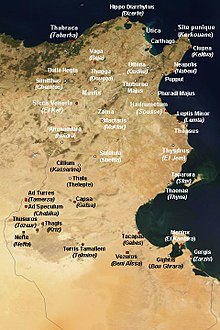
Utica was an ancient Phoenician and Carthaginian city located near the outflow of the Medjerda River into the Mediterranean, between Carthage in the south and Hippo Diarrhytus in the north. It is traditionally considered to be the first colony to have been founded by the Phoenicians in North Africa. After Carthage's loss to Rome in the Punic Wars, Utica was an important Roman colony for seven centuries.

Hadrumetum, also known by many variant spellings and names, was a Phoenician colony that pre-dated Carthage. It subsequently became one of the most important cities in Roman Africa before Vandal and Umayyad conquerors left it ruined. In the early modern period, it was the village of Hammeim, now part of Sousse, Tunisia.
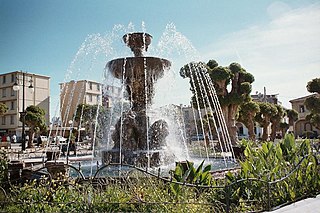
Cherchell is a town on Algeria's Mediterranean coast, 89 kilometers (55 mi) west of Algiers. It is the seat of Cherchell District in Tipaza Province. Under the names Iol and Caesarea, it was formerly a Roman colony and the capital of the kingdoms of Numidia and Mauretania.
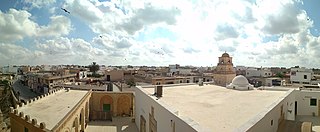
El Djem or El Jem is a town in Mahdia Governorate, Tunisia. Its population was 21,576 during the 2014 census. It is home to Roman remains, including the Amphitheatre of El Jem.

Maktar or Makthar, also known by other names during antiquity, is a town and archaeological site in Siliana Governorate, Tunisia.

The Punic people, usually known as the Carthaginians, were a Semitic people who migrated from Phoenicia to the Western Mediterranean during the Early Iron Age. In modern scholarship, the term Punic, the Latin equivalent of the Greek-derived term Phoenician, is exclusively used to refer to Phoenicians in the western Mediterranean, following the line of the Greek East and Latin West. The largest Punic settlement was Ancient Carthage, but there were 300 other settlements along the North African coast from Leptis Magna in modern Libya to Mogador in southern Morocco, as well as western Sicily, southern Sardinia, the southern and eastern coasts of the Iberian Peninsula, Malta, and Ibiza. Their language, Punic, was a dialect of Phoenician, one of the Northwest Semitic languages originating in the Levant.
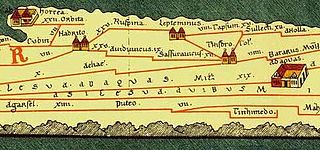
Leptis or Lepcis Parva was a Phoenician colony and Carthaginian and Roman port on Africa's Mediterranean coast, corresponding to the modern town Lemta, just south of Monastir, Tunisia. In antiquity, it was one of the wealthiest cities in the region.
Ruspe or Ruspae was a town in the Roman province of Byzacena, in Africa propria. It served as the episcopal see of Saint Fulgentius of Ruspe. It is now a Roman Catholic titular bishopric.
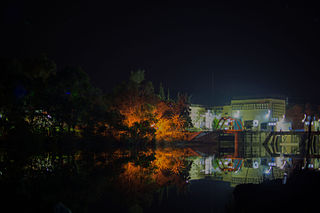
Tebourba is a town in Tunisia, located about 20 miles (30 km) from the capital Tunis, former ancient city and bishopric, now a Latin Catholic titular see.
Uzita was a Roman period town and bishopric in the Roman province of Byzacena, in present-day Tunisia. It continues to be a Latin Catholic titular see.

Djinet, the classical Cissi, is a port town and commune in the Bordj Menaïel District of Boumerdès Province, Algeria, east of the mouth of the Isser River and around Cape Djinet. As of 2008, the population of the municipality is 21,966.

Zama, also known as Xama, is in what is now Tunisia and is best known for its connection with what is called the Battle of Zama in which on 19 October 202 BC, Scipio Africanus defeated Hannibal, which ended the Second Punic War with victory for the Roman Republic and broke the power of Ancient Carthage.
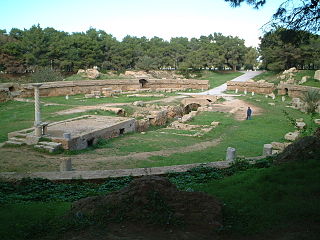
The Carthage Amphitheatre was a Roman amphitheatre constructed in the first century CE in the city of Carthage, Tunisia, which was rebuilt by Dictator Julius Caesar and became the capital of Africa Proconsularis.

Acholla also latinised as Achilla or Achulla, was a Roman-Berber city on the sea-coast in the ancient province of Africa Propria (Byzacena) in modern Tunisia. It was located little above the northern extremity of the Lesser Syrtis, and about 20 Greek miles south of Thapsus. It was a colony from the island of Melita (Malta), the people of which were colonists from Carthage. Under the Romans, it was a free city. In the African War, 46 BCE, it submitted to Julius Caesar, for whom it was held by Messius; and it was in vain besieged by the Pompeian commander Considius.
Rougga is a town in southern Tunisia located in Sfax Governorate, on the Oued er Rougga wadi. Rougga is the Berber name of the town, which is known as Raqqa in Arabic. The town is located on the site of Ancient Roman African city and former bishopric Bararus, which remains a Latin Catholic titular see.

Ounga, also known as Younga and Jounga, is an archaeological site on the Mediterranean coast of Tunisia, located 45 km (28 mi) south of Sfax along the Mediterranean coast. The area is also known for its oil fields.
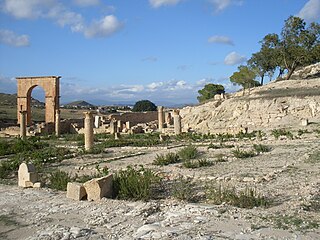
Pheradi Majius is a locality and archaeological site in Tunisia located at 36.250003°N 10.397047°E near the modern town of Sidi Khalifa in Sousse Governorate, Tunisia that is located at 36° 14′ 58″ N, 10° 23′ 57″E.

Iomnium was a Phoenician, Carthaginian, and Roman port on Algeria's Mediterranean coast at the site of present-day Tigzirt.
Rusubbicari was a Phoenician and Carthaginian colony and Roman town. It has been tentatively identified with ruins at Zemmouri El Bahri, Algeria. The Roman town was in the province of Mauretania Caesariensis.
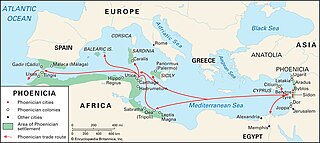
The Phoenician settlement of North Africa or Phoenician immigration to North Africa was the process of Phoenician people migrating and settling in the Maghreb region of North Africa, encompassing present-day Algeria, Libya, Morocco and Tunisia, from their homeland of Phoenicia in the Levant region, including present-day Lebanon and Syria, in the 1st millennium BC.
